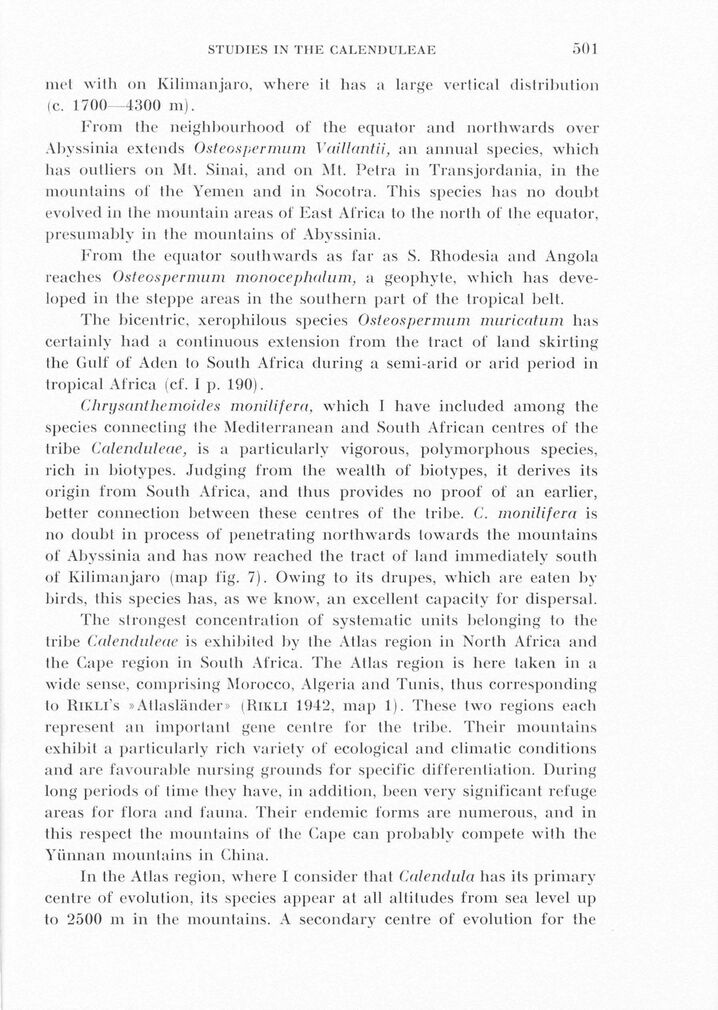
Full resolution (JPEG) - On this page / på denna sida - Sidor ...

<< prev. page << föreg. sida << >> nästa sida >> next page >>
Below is the raw OCR text
from the above scanned image.
Do you see an error? Proofread the page now!
Här nedan syns maskintolkade texten från faksimilbilden ovan.
Ser du något fel? Korrekturläs sidan nu!
This page has never been proofread. / Denna sida har aldrig korrekturlästs.
STUDIES IN THE CALENDULEAE
501
mel with ön Kilimanjaro, where il lias a large vertical distribution
(c. 1700 -4300 in).
From the neighbourhood of the equator and norlhwards över
Abvssinia extends Osteospermum Vaillantii, an annual species, which
has outliers ön Mt. Sinai, and ön Mt. Petra in Transjordania, in the
mountains of the Yemen and in Socotra. This species has no doul)t
evolved in the mountain areas of East Africa to the north of the equator,
presumablv in the mountains of Abvssinia.
From the equator soulhwards as far as S. Rhodesia and Angola
reaches Osteospermum monocephalum, a geophyte, which has
deve-loped in the steppe areas in the southern part of the tropica I belt.
The bicentric, xerophilous species Osteospermum muricatuin bas
certainlv had a continuous extension from the tract of land skirting
the Gulf of Aden to South Africa during a semi-arid or arid period in
tropical Africa (cf. 1 p. 190).
Chrysanthemoides monilifera, which I have included among the
species connecting the Mediterranean and South African centres of Ihe
tribe Calenduleae, is a paiticidarly vigorous, polymorphous species,
rich in biotypes. Judging from the wealth of biotypes, il derives ils
origin from South Africa, and thus provides no proof of an earlier,
better connection between these centres of the tribe. C. monilifera is
no doubl in process of penetrating northwards lowards the mountains
of Abvssinia and has now reached the tract of land immediately soulh
of Kilimanjaro (map fig. 7). Owing to its drupes, which are eaten by
birds, this species has, as we know, an excellent capacity for dispersal.
The strongest concentration of systematic units belonging lo the
|ribe Calenduleae is exhibited by Ihe Atlas region in North Africa and
the Cape region in Soulh Africa. The Atlas region is here taken in a
wide sense, comprising Morocco, Algeria and Tunis, thus corresponding
to Rikli’s »Allasländer» iRikli 1942, map 1). These two regions each
represen! an important gene centre for the tribe. Their mountains
exhibit a particularly rich variety of ecological and climatic conditions
and are favourable nursing grounds for specific differentiation. During
long periods of lime Ihev have, in addition, been very significant refuge
areas for flora and fauna. Their endemic forms are numerous, and in
this respect the mountains of the Cape can probably compete with the
Yiinnan mountains in China.
In Ihe Atlas region, where I consider that Calendula has ils primary
centre of evolution, ils species appear at all altitudes from sea level up
to 2500 m in the mountains. A secondary centre of evolution for the
<< prev. page << föreg. sida << >> nästa sida >> next page >>